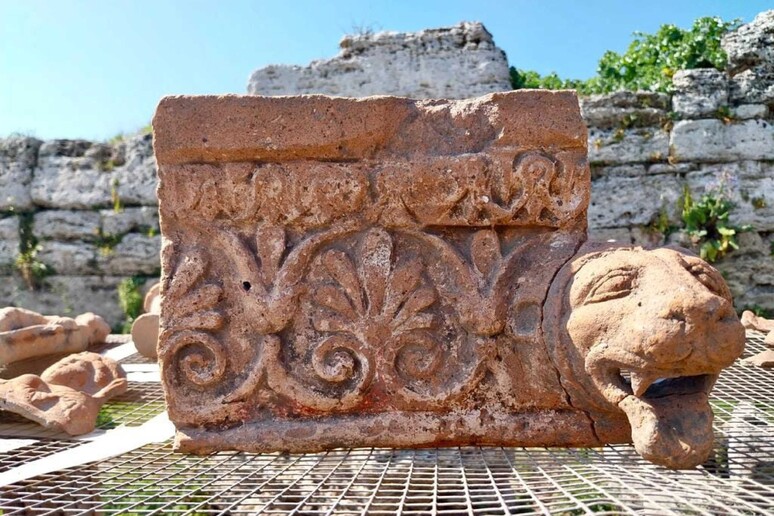(By Silvia Lambertucci)
The excavations to uncover the
temple discovered in 2019 by the ruins of the walls of the
ancient Greek city of Paestum have produced some huge surprises.
They include a stone pedestal with steps, coloured terracotta
roof decorations with lion-shaped dripstones, an extraordinary
gorgon and a moving depiction of Aphrodite.
Then there are seven bull heads, an altar with groves in the
stones to collect sacrifice liquids and hundreds of ex votos,
with votive offerings with images of Eros riding a dolphin in
the way of Poseidon, the god who gave his name to the city,
standing out.
Tiziana D'Angelo, the Director of the Paestum archaeological
site, told ANSA that the dig was set to "change the recorded
history of ancient Poseidonia"
It is almost like window on a 500-year-long fragment of the life
of the city that Greeks from Sybaris founded in 600 BC and was
then conquered by the Lucanians before becoming a colony of
Rome.
It's a truly unique context that "shines a very interesting
light on ancient religious life" said Culture Ministry Museums
Director General Massimo Osanna.
He recalled that the archaeological research done at Paestum in
the 1950s around the site's big temples was not scientifically
documented.
A new excavation campaign was launched in 2020, but it was soon
halted by the COVID-19 pandemic and resumed a few months ago.
"What we have before us today is the moment in which the temple
was abandoned, between the end of the second century BC and the
start of the first, for reasons that are yet to be clarified,"
said D'Angelo.
Analysis of the clay decorations made it possible to date its
foundation to the first quarter of the fifth century BC, when
some of the most important monumental buildings that are still
with us today were built - the Temple of Hera, built between 560
and 520 BC, and the Temple of Athena, which dates back to 500
BC.
The Temple of Neptune, on the other hand, was completed later,
in 460 BC.
The 'little temple' (tempietto) is small, measuring 15.6 metres
by 7.5 metres, with four columns at the front and seven on the
sides.
Like the others, it is in the Doric order, but it is
distinguished but the purity of its shapes.
"It is the smallest peripteral Doric temple that we know of from
before the Hellenistic period, the first building that Paestum
fully expresses in the Doric canon," explained Gabriel
Zuchtriegel, the former director of the Paestum archaeological
site who is now in charge of Pompeii and has just published a
major study on Doric architecture.
"It's almost a model, a small version of the big Temple of
Neptune (which must have been in construction at the time), a
sort of missing link between the sixth and fifth century BC".
So it is very important, in part because, to some degree, it
demonstrates the community's artistic and cultural autonomy and
disproves those who have always believed that the colonies
limited themselves to copying the works of the motherland.
The range of objects found in the space that separates the front
of the building to the altar is extraordinary too: terracotta
statuettes with the faces of the donors or of divinities, with
15 featuring a little Eros riding a dolphin, and miniature
temples and altars.
They are little masterpieces of craftsmanship that are in
addition to the seven bull heads found around the altar, perhaps
"props" for the cleric.
D'Angelo said that they seem to have been placed on the ground
with devotion, "as if in a rite of closure" when the temple,
which was still used in the Lucanian period, went it disuse with
the arrival of the Romans in 273 BC.
"There's a surprise every day," said the director, surrounded by
a team of archaeologists coordinated by Francesco Mele.
It will take time to understand more as study, restoration and
laboratory tests will be needed.
In the meantime, research is continuing to document every period
in the life of the temple up to its construction, with the aim
of also understanding why part of the city wall collapsed on the
back of the building.
There are "very many" elements of major interest said D'Angelo
with excitement.
These include the signature on one of the statuettes with the
dolphins of the Avili, "a family of potters, almost known in
Delos, whose presence in Paestum had never been documented".
Then there is the very special position of this temple, built in
the city but far from the centre and from the other temples,
right by the city walls and very near to the sea, almost looking
out onto it.
"The ships that passed by found it in front of them," she
pointed out.
Then there are the cherubs on the dolphins and a Roman coin from
the third century BC that had Eros riding a dolphin on one side
and Poseidon on the other.
Was the temple named after the god whose name was given to
another city?
"It's too early to say," D'Angelo said.
"But it's an extremely interesting hypothesis".
In short, it is just an idea to ponder on during the wait for
the excavations to shed more light on history.
ALL RIGHTS RESERVED © Copyright ANSA











